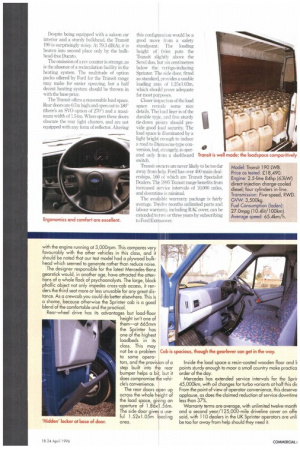MERCEDES SPRINTER a he 312D high-roof 1W13 model is the largest
Page 48

Page 49

If you've noticed an error in this article please click here to report it so we can fix it.
in the Sprinter range. Other variants are offered with wheelboses from 3.0m to 4.03m, five gross weights from 2.6 to 4.6 tonnes, and two roof heights.
The Sprinter cab is comfortable but unremarkable. Large areas of easily cleaned plastic trim are practical, but do little for overall refinement. There's plenty of space for the most awkward shaped drivers, with a maximum 0.82m between the dashboard and the seat backs. The driver's seat has a maximum height of 1.08m from the ground, and can be lowered to 1.0m.
As a working environment the Sprinter is perhaps better than it might first appear—instruments are easy to read and all the controls are within easy reach. Most remarkable, however, is the amount of storage space. Van drivers have long been used to using the passenger seat as a luggage shelf; that's not necessary with the Sprinter. Along with the usual glovebox and door pockets the seat supports act as usable space for tools and overalls, while spaces concealed in the lower half of each interior door panel provide a good hiding place for valuables. Continuing the security theme, we liked the filler cap cover, which requires the passenger door to be opened before the tank can be accessed. Given that the Sprinter has a fuel tank capacity of 80 litres, anything which reduces the attentions of the surreptitious siphoner gets our vote.
One aspect of the Mercedes which deserves special mention is the positioning of the fuse panel, inside the driver's seat support. That it took four CM testers the best part of 15 minutes to find it is acceptable, and perhaps unsurprising. That changing a fuse in the pouring rain would render the driver rather more damp than they might choose to be, is less so.
Noise levels within the Sprinter cab pass muster. At motorway speeds we recorded a figure of 75.4613(A) with the engine running at 3,000rpm. This compares very favourably with the other vehicles in this class, and it should be noted that our test model had a plywood bulkhead which seemed to generate rather than reduce noise. The designer responsible for the latest Mercedes-Benz gearstick would, in another age, have attracted the attentions of a whole flock of psychoanalysts. The large, black phallic object not only impedes cross-cab access, it renders the third seat more or less unusable for any great distance. As a crewcab you could do better elsewhere. This is a shame, because otherwise the Sprinter cab is a good blend of the comfortable and the practical.
Rear-wheel drive has its advantages but load-floor height isn't one of them—at 665mm the Sprinter has one of the highest loadbeds in its class. This may not be a problem to some operators, and the provision of a step built into the rear bumper helps a bit, but it does compromise the vehicle's convenience.
Cab is The rear doors oper up across the whole heigl-t of the load space, giving an aperture of 1.86x1.56m. The side door gives a useful 1.52x1.05m loacing area. Inside the load space a resin-coated wooden floor and II points sturdy enough to moor a small country make practica order of the day. Mercedes has extended service intervals for the Sprir 45,000km, with oil changes for turbo variants at half this di5 From the point of view of operator convenience, this deserve. applause, as does the claimed reduction of service downtime less than 37%.
Warranty terms are average, with unlimited twelve-month and a second year/125,000-mile driveline cover on offe said, with 110 dealers in the UK Sprinter operators are unli be too far away from help should they need it
Model: Sprinter 312D LWB. Price as tested: 220,470. Engine: 2.9-litre 122hp (90kW) direct-injection charge-cooled diesel. Five cylinders in-line. Transmission: five-speed, RWD. GVW: 3,500kg.
Fuel Consumption (laden): 29.0mpg (9.71it/100km). Average speed: 67.5km/h.




















































































































